Dave Clawson and Steve Forbes have contributed to the revitalization of two storied Wake Forest programs.
A Tale of Two ACC Coaches of the Year
"Good to Great", "Get Right" and the story behind the leaders of Wake Forest's basketball and football renaissance
April 8, 2022
Wake Forest, in more ways than one, is a school bound to be underestimated. Not because of its academics; the academics have always been good — 28th in the nation good, by the US News and World Report’s calculation. But on paper, Wake Forest looks anything but an athletic powerhouse.
There’s a reason the school is so heavily underestimated in college athletics. One word can encapsulate it all — small. With 5,441 undergraduate students, not only is it the smallest school in the ACC, Wake Forest is the smallest school in all of the Power Five — comprised of the ACC, SEC, Big 10, Big 12 and Pac 12.
Wake Forest has the looks of a Division III school in New England. The red brick buildings, the big chapel that dominates campus, the luscious green quads, all of it is quaint and unintimidating. Wake Forest is described as a walking campus. It’s that small. It’s no Duke, Clemson or North Carolina.
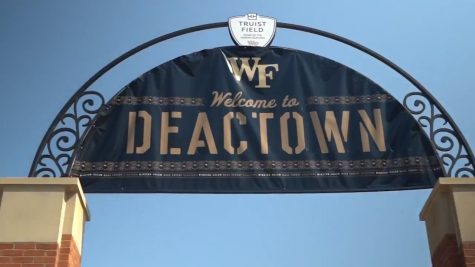
But just as you are ready to write this school off as some academic workhorse and nothing else, the big fence near Angelou Residence Hall juts out. Covered in black tarps from the inside, you can’t see through at eye-level, only from the hilltop. There are two massive practice fields lined by “DEACON TOUGH” signage. To their left lies a grandiose football fieldhouse and the state-of-the-art Shah Basketball Complex. However, even with these pristine facilities, until very recently, the question remained: can Wake Forest really be a football or basketball school?
This was not always the case – back in the early 2000s, one didn’t need to question the athletic prowess of Wake Forest football and basketball. In 2006, the football team won the ACC Championship; in 2003, the men’s basketball team won the ACC Regular Season Championship and it made the Sweet Sixteen in 2004. Chris Paul once graced the campus.
After then, though, the glory days were over, and in the decade-and-a-half since, Wake Forest had lain dormant. The Demon Deacons were just another stop on the schedule for any ACC team — an unknown quantity to any college sports fan living outside the state of North Carolina.
The end of this dormancy all started with two phrases — “Good to Great” and “Get Right”. Those five words encapsulate years of strife within Wake Forest University’s football and men’s basketball programs, respectively, as well as the time it took to make everything right again.
Enter: Dave Clawson and Steve Forbes. For both, the beginning was a struggle. It wasn’t an overnight fix. But now, after the anguish of COVID-19 in 2020, Wake Forest found success and revitalization in these two coaches and programs in 2021. With “Good to Great” powering football, Clawson turned a 4-5 shortened-season football team in 2020 into an 11-3 ACC Atlantic Division champion in 2021. Forbes took “Get Right” to heart and flipped a 6-16 ACC bottom-dweller with only three in-conference wins into a 25-10 team that came one win away from a bid to the NCAA Tournament.
These two coaches awoke the Demon Deacons. It is evident from the postgame Instagram posts of students and the energy in the Joel Coliseum and at Truist Field, respectively, that Wake Forest is once again a basketball and football school. With these coaches at the helm, the 2021-2022 school year has been unlike any other. Clawson and Forbes are the renaissance leaders. They are Wake Forest football and basketball, and this is their story.
Dave Clawson talks into his headset in full Bowling Green getup.
Dave Clawson: The Journey
“I was 25 years old. I had an undergraduate degree and a master’s degree, and I could not find a job. I took a job working at the Cooker Bar and Grill in Columbus, Ohio. I was just trying to make enough money to survive.” – Dave Clawson
Freshly graduated from Williams College, the highest-ranked liberal arts college in the country, Dave Clawson soon found himself in a daunting position. After a year as a graduate assistant at the University at Albany and two years as an assistant coach at the University of Buffalo, he was fired for the first time.
“After my second year [at Buffalo], the head coach left, and we all got let go,” Clawson reminisced. “So I was 25 years old. I had an undergraduate degree and a master’s degree, and I could not find a job.”
A diploma from one of the best schools in the country would cause little concern for most. For Clawson, there was a major problem, though. A job in football was nowhere to be found. So, with two degrees in hand, he found a job at the Cooker Bar and Grill in Columbus, Ohio.
“I was waiting tables, trying to make enough money to survive so that I could get back into coaching,” Clawson said.
Rather than being discouraged, Clawson recalled his time at the Cooker fondly. It was there that he first realized how much being a coach meant to him and that it would be something he wanted to do for the rest of his life.
“I was probably more determined than ever at that point,” Clawson said. “I knew that I wanted to coach because, even in those three to four to six months that I was waiting tables, I missed it. I missed being part of a team, I missed coaching and I missed being around student athletes.”
Clawson continued: “At that point, there were no U-turns.”
Even after finally getting a job as the running backs coach at Lehigh University, Clawson thought back to his time as a waiter often. It was motivation, a memory of a time when life wasn’t so easy.
“I have my Cooker Bar and Grill name tag right in front of my computer,” Clawson said. “I keep it there every day, just as a reminder of where I’ve come from.”
He wasn’t lying. As I prepared to leave Clawson’s office, the interview completed and the thanks given, he called me back in. With a smile on his face, Clawson says, “Here, I want to show you something.” As I approach his desk, I notice two name tags propped against his computer. On the right, with a sharp black background and gold lettering, is his name tag for Wake Forest. It reads: Dave Clawson, Head Football Coach. On the left is his faded-looking name tag from Cooker Bar and Grill. It reads: Dave.
After the Cooker Bar and Grill, Clawson was hired as an assistant coach at Lehigh for one year, then spent two more as the Mountain Hawks’ offensive coordinator. After Lehigh, Clawson spent three years as the offensive coordinator at Villanova. Finally, in 1999 — six years removed from the Cooker — Clawson finally reached the position of head coach at Fordham University.
The year before Clawson became the head coach at Fordham, the team went 4-7. In Clawson’s first year, they didn’t win a single game, going 0-11. Once again, questions on if coaching was for him set in. But just like at the Cooker, there were no U-turns. The work had to go on.
From there, it got better: 3-8 in 2000, then 7-4 in 2001 and finally 10-3 in 2002, when the Rams made it to the FCS Quarterfinals for the first time in program history and finished as the No. 12 team in the nation. That year, Clawson was named both the Patriot League and I-AA National Coach of the Year. Following a 9-3 year in 2003, he departed Fordham having broken 61 team and individual records.
After Fordham, Clawson took a step forward to Richmond as the head coach. From 2004 to 2007, he led the Spiders to three consecutive winning seasons for the first time in 52 years. In his final year, Richmond notched a school-record 11 wins and reached the FCS Semifinals, and Clawson was named the Virginia Division I Coach of the Year, beating out Virginia Tech’s Frank Beamer and Virginia’s Al Groh.
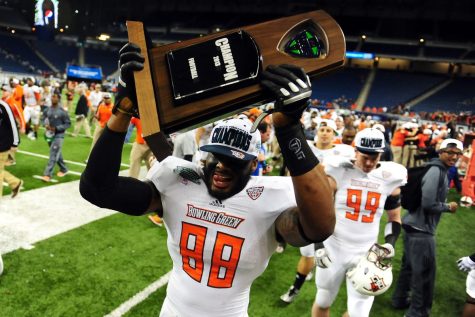
Then, 15 years removed from the Cooker, Clawson hit the big-time — SEC football — taking over for David Cutcliffe as offensive coordinator on Phillip Fulmer’s staff at Tennessee. Clawson, however, left the program after a tumultuous year in Knoxville and was out of a coaching job for the first time since 1992.
But life for Clawson was not like what it was in his Cooker days. Just days after leaving the Tennessee program, he was named the head coach at Bowling Green University. There, Clawson put his name on the map, winning the 2013 Mid-American Conference Championship over then-No. 16 Northern Illinois, the program’s first conference championship since 1992.
That night, then Wake Forest President Nathan Hatch and Athletic Director Ron Wellman were in the crowd. Four days later, Clawson was announced as the next head coach at Wake Forest.
Steve Forbes coaches his team at East Tennessee State University.
Steve Forbes: The Journey
“I went from gravel roads to Tobacco Road.” -Steve Forbes
Steve Forbes’ journey to Wake Forest was long and winding, but it works for him. In a way, Forbes was made for this kind of long trek. He’s a storyteller. When I asked him about his experience before Wake Forest, Forbes spoke for over three minutes straight. There’s a lot to tell, but the story is too good to leave anything out.
Forbes’ journey began in Lone Tree, Iowa, where he graduated with a class of 32 people. Despite graduating third in his class, Forbes found himself in community college.
“I wanted to get recruited,” he said.
From there, he moved on to Southern Arkansas, where he proclaims he was “probably a better baseball player than a basketball player.”
Before coaching, Forbes worked for a year as a Sports Information Director at Southern Arkansas. It wasn’t easy.
“I made $6,000 with no benefits,” Forbes said. “I didn’t have a computer. Everything was a typewriter. My wife was teaching fourth grade in Waldo, Arkansas.”
After a year of administrative work, Forbes secured a coaching job at Southwestern Community College in Iowa. Two years later, he was the head coach. In what may seem like a lateral move to those not familiar with junior college basketball, Forbes left Southwestern to become an assistant coach at Barton Community College in Kansas. After two more years, he was the head coach.
The journey may seem monotonous, but Forbes remembers every minute. Wikipedia may tell you the right answer too, but Forbes has the years right off the top of his head.
“I spent nine years in junior college before I ever went Division I,” he said.
But, after those nine years, Forbes broke through, joining Idaho as an assistant for two years. Then, it was on to Louisiana Tech as an assistant for three.
At his next stop, Illinois State, Forbes worked with his first Final Four coach, Porter Moser, who took Cinderella Loyola-Chicago to the Final Four in the 2018 NCAA Tournament.
After a year with Moser, Forbes finally made it to Power Five basketball, joining Texas A&M as an assistant. That year with the Aggies foreshadowed things to come.
“That was my first chance at the high-major level with Billy Gillispie,” Forbes said. “Billy was the Big 12 Coach of the Year when I was there. We had the largest turnaround in the conference.”
After two years at Texas A&M, Forbes finally found stability with Bruce Pearl at Tennessee.
“We had a great run there,” Forbes said. “We averaged 25-26 wins a season. [Pearl] was the SEC Coach of the Year and we won the SEC for the first time in 40 some-odd years. We went to the Elite Eight and a couple Sweet Sixteens.”
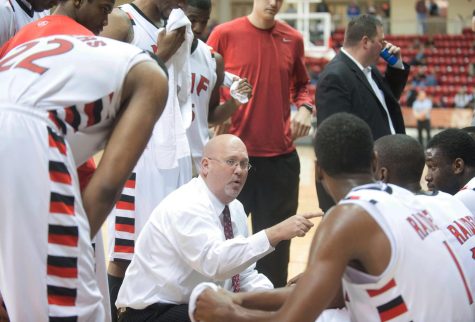
But then, the stability ended. Pearl, along with the rest of his staff, including Forbes, was fired. Due to the nature of Pearl’s firing, with alleged recruiting violations, Forbes’ fall down the ladder of college basketball was large. He had to start all over again. And so he did, right back to the kind of school his career began at 22 years before — junior college.
“It was really refreshing, to be honest with you,” Forbes said of his time at Northwest Florida State. “I got back to doing what I really love to do and that’s just coach. It wasn’t about the money or the prestige of the SEC, it was just helping young people turn their dreams into reality.”
Forbes continued: “I needed it. I needed to go back to my roots. I needed to do some self-evaluation of where I was at in my life. And it was good for my family, for our spirituality and our togetherness, I think it was really good for us. When one door closes, another one opens. I really don’t think I would be here had that not happened.”
Forbes’ success in Florida was astounding. Over the course of two years, he went 62-6, while also sending five players to Division I basketball. That success gave him another chance at the majors, this time around with Gregg Marshall and Wichita State. In those two years, fresh off an appearance in the Final Four, the Shockers went 65-5.
Then, in the second stable job of his career, Forbes found a home in Tennessee again, coaching East Tennessee State for five years. In his final season, where COVID-19 kept the conference-champion Buccaneers from going to the NCAA Tournament, Forbes was named the So-Con Coach of the Year.
“It’s an interesting path,” Forbes said of his journey. “I wouldn’t trade it for anything. I think it’s made me who I am. It just goes to show that you can turn your dreams into reality if you work hard and stay focused on the process.”
Courtesy of Wake Forest Athletics
The Wake Forest student section is scarcely populated for a 2015 game.
Dave Clawson: The Struggle
“When you go from a MAC school like Bowling Green to an ACC school like Wake Forest, you expect all the facilities to be better. And none of it was better.” -Dave Clawson
When Clawson was hired by Wake Forest, he saw the type of school that fit him as a head coach. It brought him back to his time at Richmond.
“There’s a lot of similarities between the challenges at Richmond and the challenges at Wake Forest,” Clawson said. “[Both] are small, private academic schools in what was predominantly a land-grant state-school league. We had tougher academic standards than most of our competition and it was more academically rigorous.”
For many coaches, those academic standards would be a sour note. But, to Clawson, they were a positive one.
“A lot of [my coaching journey] has been shaped by where I went to school,” he said. “[Williams] was academically rigorous, and yet sports was still important. Even though we were Division III, there was an expectation of high achievement in both [academics and athletics]. Those two things were capable of working together.”
Because his stops often included schools that valued both academics and athletics, Clawson always looked at Wake Forest as a dream job.
“What Wake Forest did [under Head Coach Jim Grobe] was motivation [for me] that I could do it at Richmond,” Clawson said. “I never thought the Wake Forest job would open. Grobe had a great run of success here and he seemed like he was going to be here forever. But it was always a place that I thought if that job would ever open, that would be a place I’d love to be at.”
With the desire to coach at Wake Forest in mind, Clawson signed the contract with the Demon Deacons before ever visiting the school. A day after winning the MAC Championship, President Nathan Hatch and Athletic Director Ron Wellman visited Clawson at his home in Bowling Green.
“[They] interviewed me and offered me the job, and said, ‘we want you, but we need to get this thing filled. We’re having a press conference tomorrow,’” Clawson remembered.
And so, Clawson accepted the job, sight unseen. He had always looked at Wake Forest fondly, and the opportunity to coach there opened at just the right time. But, for a program that had won the ACC Championship in 2006, the situation in Winston-Salem was surprising and concerning to Clawson.
“The facilities were awful,” he said. “I was in shock. [Wake Forest] didn’t have an indoor facility. Bowling Green did. The weight room at Bowling Green was far better. Our meeting rooms at Bowling Green were better, our offices were better. I was surprised by how poor the facilities were. When you see how poor the facilities were, you then understand why the football team had struggled.”
With the facilities in Winston-Salem being worse than what he experienced in the MAC, Clawson was presented with a challenge. To him, that meant changing the culture, which began with recruiting. Clawson knew that Wake Forest, other than a great education, did not have much to offer at the time. The only other thing he could sell to recruits was playing time.
“We were talent deficient,” Clawson said. “Not on defense. The defense we inherited was very good. But offensively, almost our entire offense at Bowling Green would have started at Wake Forest.”
That talent deficiency led Clawson to bring players in who would play early and often. Players like John Wolford, Justin Herron and Phil Haynes — all three of whom now play in the NFL. Once Clawson was able to recruit talent, the goal was to make the program sustainable. That meant capitalizing on good times in the program in order to leverage growth in facilities.
“If you look at the history of Wake Forest football, there’ve been these little blips of success, one year or two years of good seasons, but it always fell right off,” Clawson said. “I found that if we could have that one good season, the only way it would be sustainable is if we started building facilities.”
It took time for that first good season to come. In both of Clawson’s first two years at Wake Forest, 2014 and 2015, the team finished the season 3-9. Despite the poor record, Clawson knew he had a reason to stay in Winston-Salem.
“You know what? It wasn’t easy,” he said. “We were so young, but even though the record didn’t change from 2014 to 2015, we were more competitive and the schedule was harder. We were in more games. We were getting to the third and fourth quarter, and they were still competitive games.”
Clawson continued: “We came out of 2015 saying, ‘Hey, if we can take that same step and have that same improvement, the goal in 2016 was to get to a bowl.’”
And in 2016, Clawson and Wake Forest did just that, going 6-6 in the regular season, and then finishing the season with a victory over Temple in the Military Bowl. The next year, Wake Forest won seven games in the regular season before taking down Texas A&M in the Belk Bowl. Then, another bowl win in 2018 over Memphis after another seven-win season.
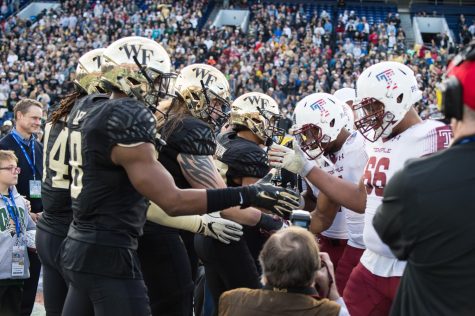
The 2019 season began promisingly for the Demon Deacons as well. The team started the season 5-0, including a primetime victory over North Carolina. But then, injuries set in, and what could have been a special season was not. Wake Forest finished 3-4 over their final seven regular-season games and then lost in their bowl matchup against Michigan State.
In 2020, the band was back together again to finish what they could not the previous season, except COVID-19 had something else to say. For a team that was prepared to make waves, Wake Forest played only eight regular-season games, winning four. A cataclysmic four second-half interceptions from quarterback Sam Hartman led to a bowl loss at the hands of Wisconsin.
But, for Clawson, 2020 was a lost year. The goal was ahead. 2020 was just a part of the process.
“My mind for the team in 2020 was, ‘Let’s not screw up 2021,’” Clawson said. “We had a chance to be good in 2020, but really good (author’s note: one might even say ‘great’) in 2021. The goal was just to keep the team together.”
Courtesy of Wake Forest Athletics
Steve Forbes answers questions from the media.
Steve Forbes: The Struggle
When Steve Forbes was hired by Wake Forest, the world was in chaos. COVID-19 was ravaging the country, and as a result, not much in college athletics changed when it came to coaching. Wake Forest was the only Power Five team to make a coaching change that summer.
“I interviewed for a couple jobs, but I never really found one that felt like it fit me,” Forbes said. “I turned down several, and then, finally, the right one came when [Athletic Director] John [Currie] called me.”
Forbes continued: “[Currie] worked with me at Tennessee, and I had a really good relationship with him. I wanted to have a great relationship with my athletic director, and I felt a tremendous comfort level with him. I felt like he wanted this program to succeed. If I was ever going to leave East Tennessee, I wanted to go somewhere that believed in me as much as [ETSU] believed in me, and I felt like John did.”
While the belief was there, COVID-19 did not do Forbes any favors. After being hired on Apr. 30, Forbes didn’t meet any of his players face-to-face until July 20. In addition, Forbes had to convince several players to stay. Olivier Sarr, a top player for the program, left for Kentucky, but Forbes was able to keep Isaiah Mucius in Winston-Salem. The process of speaking to players and convincing them of his vision for the program all had to be done virtually.
“I came down here for a couple weeks and stayed in the [Marriott] Courtyard,” Forbes recalled. “Basically, the city was shut down. So I did everything at home on my phone or on Zoom. It was unprecedented, and it wasn’t fair, not just to me, but also to the players — I didn’t have a chance to bond with them after I got the job.”
Then, when the season began, COVID-19 came calling again. After a 2-0 start in an early-season tournament, nearly the entire team contracted COVID-19, forcing the program to shut down for 33 days. Following a tune-up victory over Division II Catawba College, Wake Forest lost their first six games in the ACC. Questions began to arise about whether Wake Forest basketball was salvageable.
“I thought I could [turn it around] in the first year,” Forbes said. “That’s why I was brought here. We live in a day and age where people aren’t very patient. I had a plan in place in my mind, how to [turn it around]. That’s all you can do is put a plan in place and execute it. I didn’t really put a timeframe on it.”
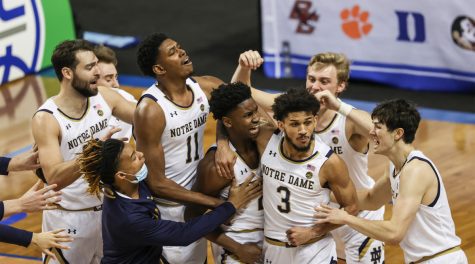
For Wake Forest, the turn didn’t come in the first year as Forbes may have hoped. The team finished 6-16 with three wins in conference and bowed out of the first round of the ACC Tournament.
“It was hard for everybody,” Forbes said. “Losing is hard. I hadn’t done that in a while, and my wife Johnetta would get on me about it. I knew it [would be hard], but I didn’t want to go through it. I know [the players] wanted to win and they were trying hard. It was a very trying year for everybody.”
Courtesy of Wake Forest Athletics
Clawson celebrates with his team after a win.
Dave Clawson: The Turn
“I really believe the conflict of 2020 made our team even closer in 2021. That’s where we came up with the theme of Good to Great. We’ve been a good program. This is the year that we take that step.” -Dave Clawson
After losing to North Carolina in 2020, Dave Clawson began to feel the seams of his team ripping apart. For a program that was supposed to be very good in 2020, the lack of success, along with the struggles of COVID-19, put a lot of stress and pressure on the situation. Something had to change.
“There was a breaking point where a lot of players wanted to opt out or not keep playing,” Clawson said. “There was a players-only meeting and I think things got pretty heated. Some of our captains — Luke Masterson, Sam Hartman, and others — drew a line in the sand that ‘we’re in this together and if you want to go, go, but don’t stay and complain.’”
That moment, while tough for the program, was the first step in getting to where Wake Forest football is today. The turning point for success in 2021 came in 2020.
“After that meeting, a few guys opted out,” Clawson said. “But after that, the rest of the team really gelled and bonded together. That’s when we came up with the theme of ‘Good to Great.’”
Clawson continued: “We were pretty bold about it. You can’t then go 5-7. We would have been a joke. But we felt good enough about the team that that was our challenge, to go from “Good to Great”. Collectively as a program, everyone embraced that challenge.”
In 2021, there were still questions lingering about the state of Wake Forest football after the failure of the 2020 season, especially in the bowl game. But within the program, there was confidence. This team was no longer just going to be consistently good, they were going to be great.
The 2021 season began with two non-conference games – games that Wake Forest should have won handily. Yet, the fear amongst the student body was that these games would be close. Maybe the Demon Deacons would even lose. Not so. Wake Forest defeated Old Dominion 42-10 and Norfolk State 41-16.
But then, there was Florida State, which, while struggling, was a program built to win ACC Championships. Yet, by the time the fourth quarter expired, the Demon Deacons had won again, this time by three touchdowns. Wake Forest was 3-0, with a Friday night showdown set against Virginia in Charlottesville. To Clawson, Wake Forest was not anything special yet. Following a 37-17 victory over the Cavaliers, things changed.
“[After the game], we looked at each other and thought ‘we can be pretty good guys,’” Clawson said. “That was a good Virginia team, and it was at Virginia. They don’t lose at home. I think, at that point, the players realized that we were good, that we had a really good football team.”
After the game against Virginia, Wake Forest was ranked in the AP poll for the first time that season — at No. 24. Following a home victory against Louisville, the Demon Deacons were ranked No. 19. Then, the Demon Deacons were No. 16 after a road win against Syracuse, No. 13 after taking down Army in West Point and No. 10 after defending Truist Field against Duke for a program-best 8-0 start. Oh, and that No. 10 was Wake Forest’s highest ranking in program history.
Then came a trip to North Carolina. Win there, and Wake Forest would have been squarely in the conversation for the College Football Playoff, no matter how odd that sounded. Halfway through the third quarter, the Demon Deacons led by 18. By the end of the game, they had lost by three.
“You add up all those [mistakes] up … we helped them,” Clawson said days after the game. “We contributed to our own demise, and to their credit, they took advantage of it.”
Wake Forest responded by not furthering that demise against NC State. Following a field-storming win over the Wolfpack to maintain its hopes of winning the Atlantic division, the Demon Deacons fell to Clemson in an ugly road game, a result that plagued men’s basketball as well. That left a game against Boston College in Chestnut Hill to secure the division. With a win, Wake Forest would return to the ACC Championship for the first time since 2006.
It wasn’t even close.
Behind three passing touchdowns and one rushing from Hartman, Wake Forest left Chestnut Hill with a 41-10 victory and a ticket to a showdown in Charlotte against Pittsburgh.
In the ACC Championship, Wake Forest was able to play their game in the first half. The Demon Deacons scored touchdowns on their first three possessions. Except, they didn’t score for the rest of the game, losing 45-21.
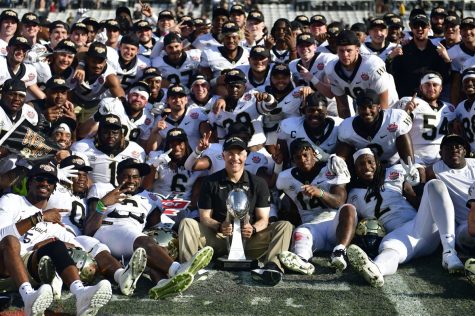
“It’s been a really special season,” Clawson said following the loss. “We’re disappointed we did not win the game. I don’t think that takes away from the season we’ve had. We’ve had a great season. We’re the Atlantic Division champions, and we have a chance to go get a Bowl championship.”
Weeks later, Wake Forest was able to notch its 11th win over Rutgers in the Gator Bowl, tying a knot on what was one of the best seasons in program history. The bowl victory gave Wake Forest their first 11-win season since the infamous ACC Championship in 2006. To Clawson, that total, along with all that was accomplished, fulfills the “Good to Great” mindset leading into the season.
“I think it’s always about raising standards, raising expectations,” Clawson said. “We are very proud of what we accomplished a year ago as Atlantic Division champions and Gator Bowl champions.”
The raised standard, and the results on the field, were reflected in the student participation and hype for the team on campus. Against NC State, 4,584 students, clad in all-black, cheered on the Demon Deacons. That number comes out to 85% of the undergraduate student body, the largest student attendance for a football game in the history of the program.
Despite the loss in the ACC Championship, the signs of “Good to Great” were still there. Wake Forest’s final AP ranking — No. 15 in the nation — was the highest the program had ever reached in its history. And Clawson should be proud too. He himself went from “Good to Great”. Following the success of the 2021 season, he was named the ACC Coach of the Year.
Courtesy of Wake Forest Athletics
Steve Forbes helps roll the quad after a victory against UNC.
Steve Forbes: The Turn
“My goal every year is to compete for the ACC championship and then make the NCAA Tournament. After eight weeks in the summer, I knew we had a good team. I knew we could win some games.”
After a dismal 2020 season, Steve Forbes looked for a way to make the turn in year two. That began with a complete overhaul of the team. The team needed to “Get Right”, a phrase that is emblazoned on its practice and workout shirts.
The cast of characters was different, too. Many players left and new faces arrived.
“I believe that recruiting is like putting together a puzzle,” Forbes said. “I wasn’t very good at putting puzzles together when I was a kid. We had to look for some different pieces. We needed skill, we needed size on the perimeter and we needed scoring.”
Forbes continued: “It’s putting together a team that fits right. I think we did a really good job with that. Beauty is in the eye of the beholder. What I see in one player, somebody else [might not]. That doesn’t mean I’m always 100% right. But I have been doing this for a long time. We know what we are looking for, and we were able to go out there and get that done.”
When Forbes first mentioned the transfers, and the process of bringing them to his program, he referenced that he “misses on some”. This past year with Wake Forest, though, Forbes hit on every single recruit he brought to Winston-Salem. All five players have made an impact on the court, and three of them are starters.
Alondes Williams, a bench player at Oklahoma, is the crown jewel of these transfers. He transformed from a player that averaged 6.7 points per game with the Sooners to one who averaged 19.3 at Wake Forest. Add on his ACC-leading 5.3 assists per game, and surprise, he becomes the ACC Player of the Year, the first transfer to ever win the award.
Jake LaRavia, a transfer from Indiana State, became the second half of one of the best one-two punches in the NCAA. He averaged nearly 15 points per game for the Demon Deacons, the second most on the team. LaRavia was named Second-Team All-ACC.
Dallas Walton, the third and final transfer starting for Wake Forest, shined in the second half of the season. At 7-feet tall, he provided a massive presence in the paint, while also having the stretch ability to hit three-pointers at a 38% clip.
Lastly, Damari Montsanto and Khadim Sy added needed skills off the bench. Montsanto proved to be a threat from behind the three-point line and Sy was another stretch big man that received votes for the Sixth Man of the Year in the ACC. Both added extra dimensions to the Wake Forest offense.

With those impactful transfers, along with the skills of Isaiah Mucius and Daivien Williamson, Wake Forest rose from the ashes in Forbes’ second year. They “Got Right”. The Demon Deacons began their season 12-1, including a win away from home against a strong Virginia Tech team. But then, Wake Forest lost their next two ACC games against Louisville and Miami — games Forbes believed the team should have won.
Over the next seven ACC games, though, the Demon Deacons went 6-1, only losing to Duke. It was during this stretch that Forbes knew he might just have a special team. Beating North Carolina at home and Virginia on the road meant something to him.
“We’ve got a chance to be good,” Forbes remembers thinking at the time.
At the time, fans of the Demon Deacons were the only ones who saw the beauty of a home win over North Carolina. When Wake Forest defeated the Tar Heels by 22 points, it verified the team’s ability to win big games, but many still saw it as a false flag. In his first year as the head coach, Hubert Davis had North Carolina at a 4-3 record in the ACC, far below expectations in Chapel Hill. Now, that win seems like Wake Forest’s biggest calling card of the year. Many within the North Carolina program have stated that the Wake Forest loss is what charged the rest of their season, one that saw them make the NCAA Championship Game.
Then, after several more wins, Wake Forest faltered at home to Miami in a game that, once again, it should have won. The Demon Deacons followed that up with a close loss in Cameron Indoor, a game that they nearly won on a buzzer-beater.
Even against Duke, losing wasn’t an option to Forbes.
“I’m not satisfied [leaving] here with a loss,” he said at the postgame press conference.
After that loss, though, Wake Forest responded, winning three of their final four games, the lone loss a stumble on the road at Clemson. With that, Forbes achieved one of his goals for the season — Top 5 in the ACC. Wake Forest slid in as the No. 5 seed leading into the ACC Tournament.
Being a good basketball team in the ACC, like football, comes with its own favors. With Wake Forest’s success on the court, the team saw their highest single-season student body attendance since 2007.
Another goal — a more personal goal — was achieved by Forbes in the beginning of March. Despite the perception that Mike Krzyzewski may have been given the award as a final curtain call, Forbes was named the ACC Coach of the Year. The first person he thought of when speaking on “Packer and Durham” following the announcement — his dad.
“My dad passed away three years ago on March 20,” Forbes said with tears forming in his eyes, alluding to the passing of Wes Durham’s father. “I can promise you that if your dad doesn’t know my dad, he does today, because my dad is the proudest person in heaven.”
Forbes then took a beat, almost for the first time recognizing the gravity of this award. The list that he is now on.
Then, still seemingly in reflection, Forbes says, “to come from gravel roads to Tobacco Road, that’s amazing.”
There was a significant buzz surrounding the Demon Deacons when they traveled to Brooklyn for the ACC Tournament. Not only did they enter as a team that was bound to make the NCAA Tournament, but also as a team that had a strong path to surprise the conference and win the ACC crown.
To many, Boston College — Wake Forest’s first opponent in the ACC Tournament — was seen as a small obstacle. The Demon Deacons defeated the Eagles by 30 points in January. It was Miami, who Wake Forest would presumably see in the quarterfinals, that was the true fear.
That unease regarding a rematch with the Hurricanes disappeared on Day Two of the ACC Tournament. Boston College made sure of that. The Eagles came out shooting hot and within three and a half minutes, they led by eight. Of course, Wake Forest would not bow out of the tournament like this. They would fight, and they did, all the way to a one-point deficit at halftime. In the second half, it was much of the same.
With the score tied, the Demon Deacons had the ball and a chance to win. It was exactly how you would draw it up — Alondes Williams with the ball, the clock counting down towards a final shot. And then things changed. A charging foul on Williams took the possession away, leaving overtime to decide the fate of Wake Forest’s season.
That overtime moved as slowly, but also as quickly, as a game ever had. Wake Forest never had a shot. Boston College couldn’t miss. Within just a minute, it was clear that this game was not the Demon Deacons’ to be won. The rest of the overtime period was as if you were watching a train wreck in slow motion. And then, the buzzer sounded. It was over. The fear of what was waiting ahead — Miami — turned into fear over whether a team that had been so incredibly special would even have a shot at the NCAA Tournament. For Wake Forest, it turned into a waiting game, but Forbes felt comfortable with where the Demon Deacons stood.
“We were safely in the tournament according to an expert on Wednesday, hadn’t played one game, and were almost out of the tournament before we played today,” Forbes said after the Boston College game. “I don’t understand how we can be penalized like that, but I guess we can. I don’t think there are 68 teams better than us, but we’re about to find out.”
When so many things had seemed to have gone Wake Forest’s way during the season, the bubble was one aspect that went entirely counter to the Demon Deacons’ wishes. Every day, there was a list of who Wake Forest would want to win, and every day, that team lost. It was painful, watching the Demon Deacons slowly slip away from the glory that had once seemed an inevitability, a prophecy.
On Selection Sunday, as many expected, Wake Forest’s name was not called. But still, the Demon Deacons were ahead of schedule. The NCAA Tournament was not a preseason expectation for those outside of the building. Success in the NIT would be beyond what anyone thought was possible.
For a while, Wake Forest looked like its old self. There was a 10-point first-round victory over Towson, then a win against VCU to send the team to the Elite Eight. But when it came to the quarterfinals against Texas A&M, Wake Forest fell back to the team that it was at its worst. It felt like the ACC Tournament, the game at Clemson or worse. The team shot under 15% in the first half. There was no way back, and for the second time, the Demon Deacons’ season felt over. This time around, it truly was.
Quarterback and redshirt junior Sam Hartman prepares for the 2022 season.
Dave Clawson: The Future
“We’re not going to surprise people anymore. We’re probably going to go into next season as a nationally ranked program. I don’t think people on the schedule are overlooking us anymore.”
When I met with Dave Clawson in early March, there wasn’t much looking back on the 2021 season. His view was mainly looking forward. The schedule for the 2022 season has already been released. The 2021 campaign is now a season of the past.
Clawson, following concerns that he might leave Wake Forest for a new job, signed a long-term contract to remain in Winston-Salem for nearly the next decade. Along with that, as Clawson mentioned, the focus is always on facilities.
Wake Forest University and the athletics department recently broke ground on a new, state-of-the-art addition to their current football complex, spearheaded by a $20 million donation by Bob McCreary, a long-time supporter of the school. The new addition will go a long way in maintaining, and adding to, Wake Forest’s ability to build the program for the future.
“Everything’s incremental,” Clawson said. “I felt that once we have some success on the field, we were going to have to show the next generation of recruits that we were committed and that this wasn’t a blip.”
With the commitment from Wake Forest, along with the success of the football program, the future looks bright.
“It was always my goal, from day one, to build a sustainable, elite program,” Clawson said. “We want to be a program that is consistently nationally ranked, whether it be the Top 20, Top 15 or Top 10.”
Clawson continued: “That’s the new standard. Can we get into the Top 10? Can we get back to the ACC championship game and win it? Can we get in to the discussion for the college football playoff? Those are the goals of the program.”
Courtesy of Wake Forest Athletics
Steve Forbes looks to improve on the 2021-2022 season.
Steve Forbes: The Future
“Fifteen years ago, I was here in the same building under the same circumstances. Then my next year at Texas A&M we went to the NCAA Tournament. We have great momentum with our program and I’m very excited for the future of Wake Forest Basketball.”
Despite the pain that missing the NCAA Tournament and losing in the NIT caused the fans of Wake Forest, the complexion of the Demon Deacons remains the same. Wake Forest is ahead of schedule. In his first year, Steve Forbes won six games. In his second year, it was 25. Who knows how many games there are to be won in year three, but if the total is more than 25, then Wake Forest will return to the NCAA Tournament. The Demon Deacons are on the other side of the bad times, and they are well on their way to going from this year — the good times — to the great times.
“We went into every single game this season with confidence and thought we were going to win,” Isaiah Mucius said after the loss to Texas A&M. “It had been a long time since I was able to feel that way. I’ve been on the dark side of Wake Forest Basketball. To be on the other side is special to me.”
Things will change. The faces of players donned in black and gold jerseys will be different. Alondes Williams and Khadim Sy will both be gone for sure. Jake LaRavia, Isaiah Mucius, Daivien Williamson and Dallas Walton have declared for the NBA Draft, but have left the door open to return and use their remaining eligibility.
And don’t forget about the signings and potential transfers that could join the program. Last year, each and every transfer had an impact. One of them was the best player in the entire conference. No matter what, Wake Forest is likely to retool and get better.
What won’t change is the face at the front of the bench — the coach and leader. Steve Forbes will be back and better than ever. With him at the helm, anything is possible.
The nearly 90% of undergraduate students who attended a Wake Forest football game against NC State is the highest in program history.
Wake Forest: The Renaissance
“I’m not sure people believed [these program’s succeeding] could happen. It’s really Wake Forest having the right leaders to capitalize on the right strengths of Wake Forest to achieve success. -John Currie
When I interviewed both Forbes and Clawson, I was intrigued by the amount of history that surrounded them. But for each coach, it was different. For Clawson, there was memorabilia from Wake Forest’s bowl games, his team’s successes, along with the name tag from Cooker, a reminder of one of the tougher times in his life. For Forbes, there were pictures of his predecessors — Dave Odom and Skip Prosser — a reminder of all that was done before him and all that was given to Wake Forest.
These historical objects in the individual coaches’ offices serve as memories of their journeys and all that predates them at Wake Forest. For Forbes and Clawson, in 30 years, theirs will be the faces in the pictures and memories sitting in the offices they once occupied. Coaches will look at their pictures, their trophies, and reflect on the impact they had on their programs, just like Forbes and Clawson do now. No school has had their men’s basketball and football coaches win the ACC Coach of the Year in the same year since 2004. Forbes and Clawson changed that. They have made history in a year where these programs – and Wake Forest’s student body – could not have needed it more.
And the future looks bright, too. To Wake Forest Athletic Director John Currie, that’s because his coaches are competitive.
“One of my favorite comments [Wake Forest] President [Susan] Wente said since she arrived here was when she said, ‘Wake Forest people are highly competitive,’” Currie commented. “I love that. I think our people are highly competitive and we expect to achieve excellence across the board whether it’s in an academic department, or whether it’s in athletics.”
Currie was also quick to reference the success of other teams on campus, and how that has impacted the desire to see success in basketball and football. Men’s tennis won a national championship in 2018, men’s soccer is consistently an NCAA Tournament team and men’s and women’s golf are among the best in the country. Nearly every team at Wake Forest has seen growth and success in the past year.
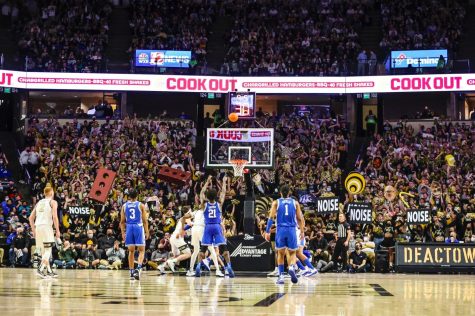
“Both programs have responded to the fact that we have really good programs at Wake Forest,” Currie said. “If you’re Coach Forbes or Coach Clawson, you can point to these other elite sports and say we can be just like this at Wake Forest. So really across the board, you can see the proverbial rising tide lifting all ships.”
This year, with all the success from teams around them, Forbes and Clawson have done something special. They have changed the game for their individual programs. They have revived them. But none of them take the credit for it.
“It’s a collaborative effort,” Forbes said. “It’s not just me. Everybody has to be on the same page. It starts with Currie, Wente and Hatch. They wanted basketball to have success. You need that commitment from your administrators to even have a chance.”
Clawson had similar thoughts.
“I think we have hired the right coaches and recruited the right people,” he said. “It’s as simple as that. You’re only as good as the people in the building with you. I have an outstanding staff who values relationships and cares about the players in ways other than football. To me, that’s what makes Wake Forest football special.”
And while both Forbes and Clawson are complimentary of the people around them, whether it’s the athletes, administrators or other coaches, they are the conductors of the train. They are the driving force behind all the positive changes. They are the key to fan engagement — students now coming to games and staying. They hold the reigns of football and men’s basketball at Wake Forest, and they have put the school back on the map.
And that’s just the beginning. Next season, football will look to return to the ACC Championship and, this time, return with the trophy. Men’s basketball will have hopes of a first shot at the NCAA Tournament in the Forbes era.
It’s the renaissance of Wake Forest men’s basketball and football. In one year, Forbes and Clawson have done it, together. Two programs, two amazing seasons and two ACC Coaches of the Year. Now, Wake Forest can sit back, smile and enjoy. It’s the good old times in DEACTOWN.
And, hey, Wake Forest baseball started the season 11-0 for the first time in nearly 70 years, but that’s certainly for another story.
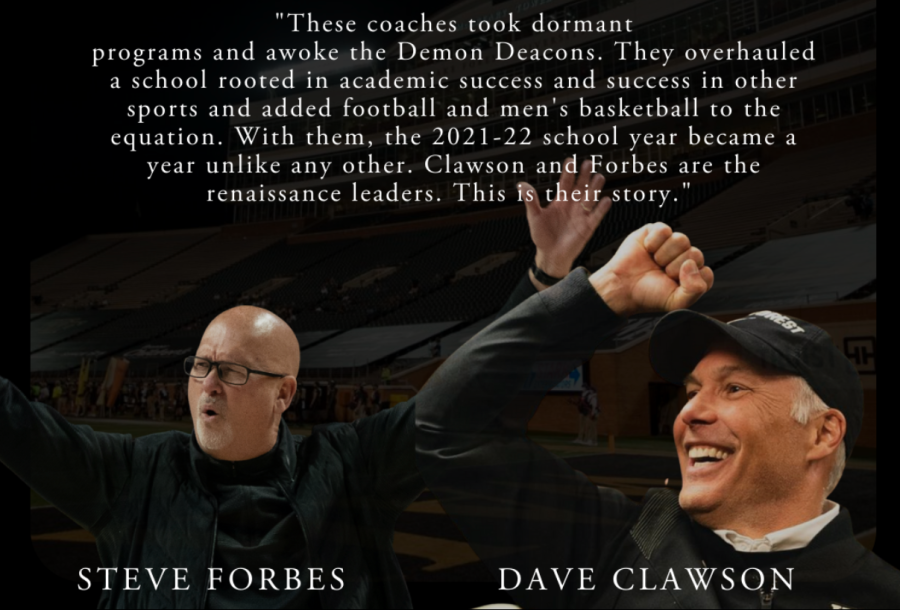
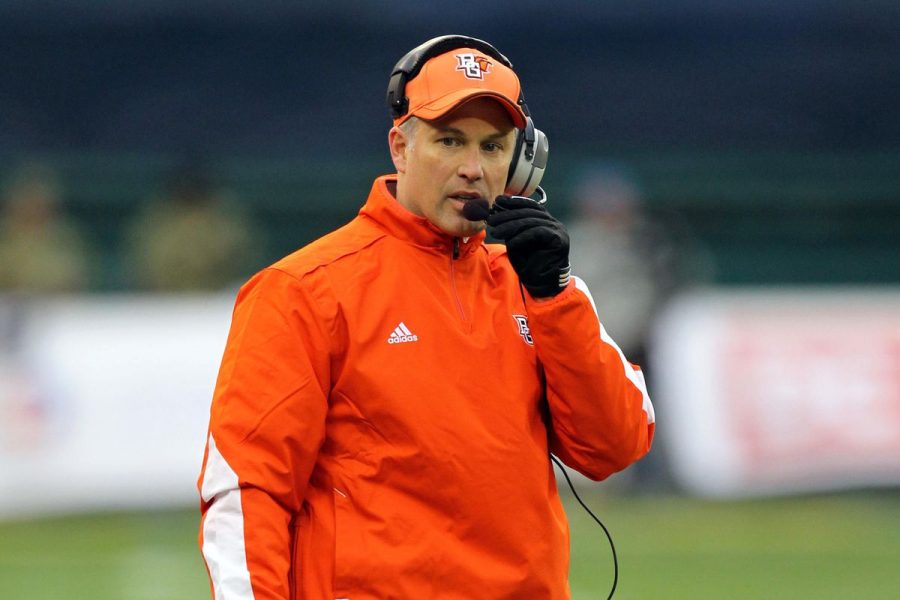
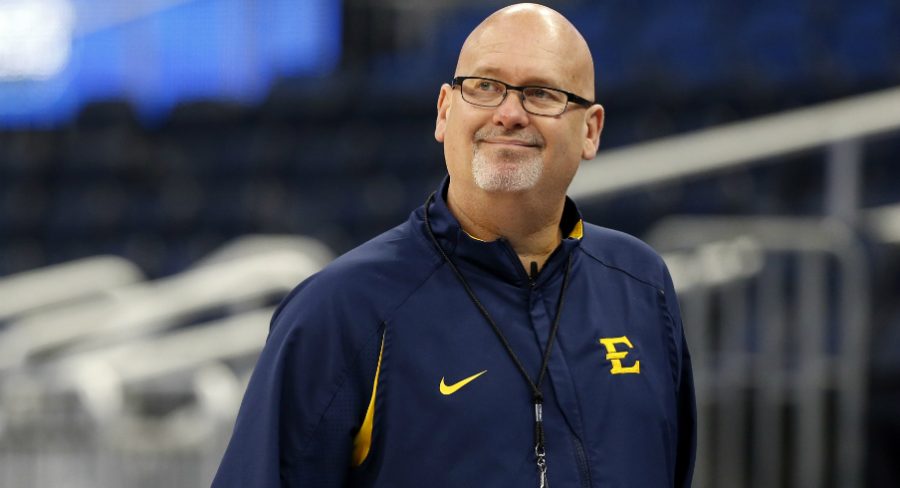
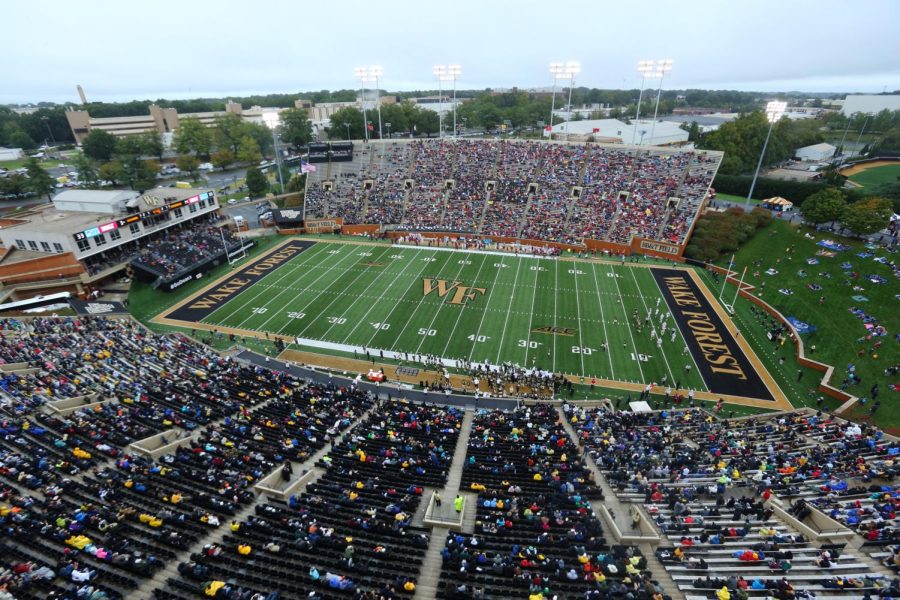
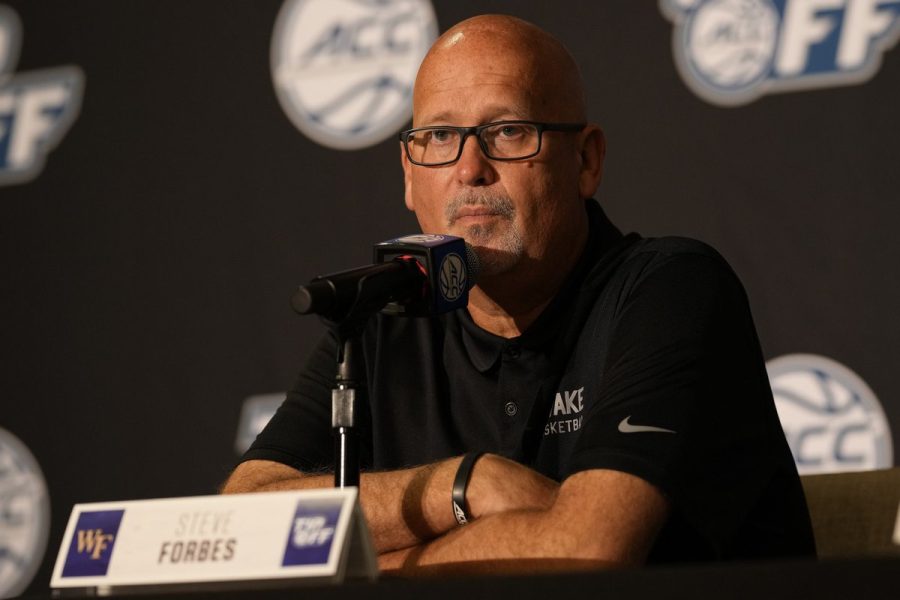
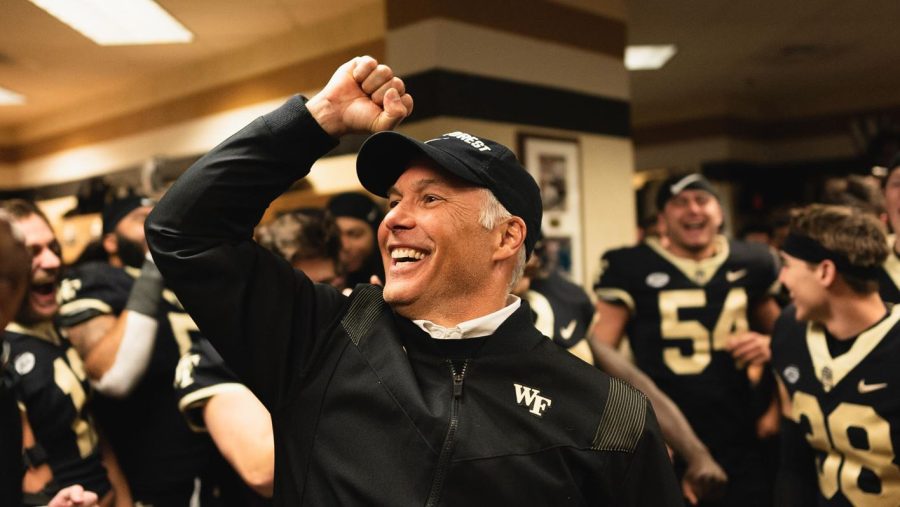
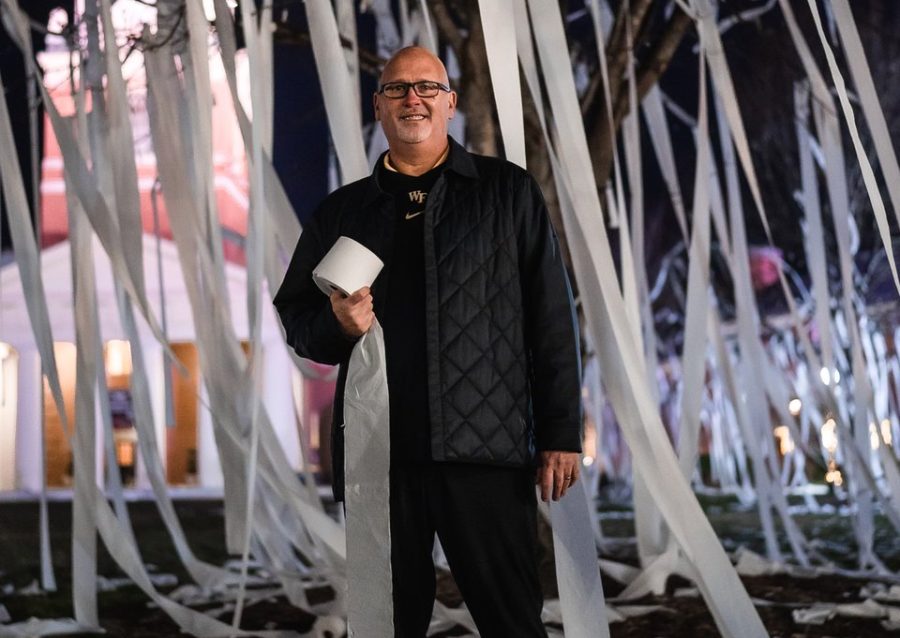
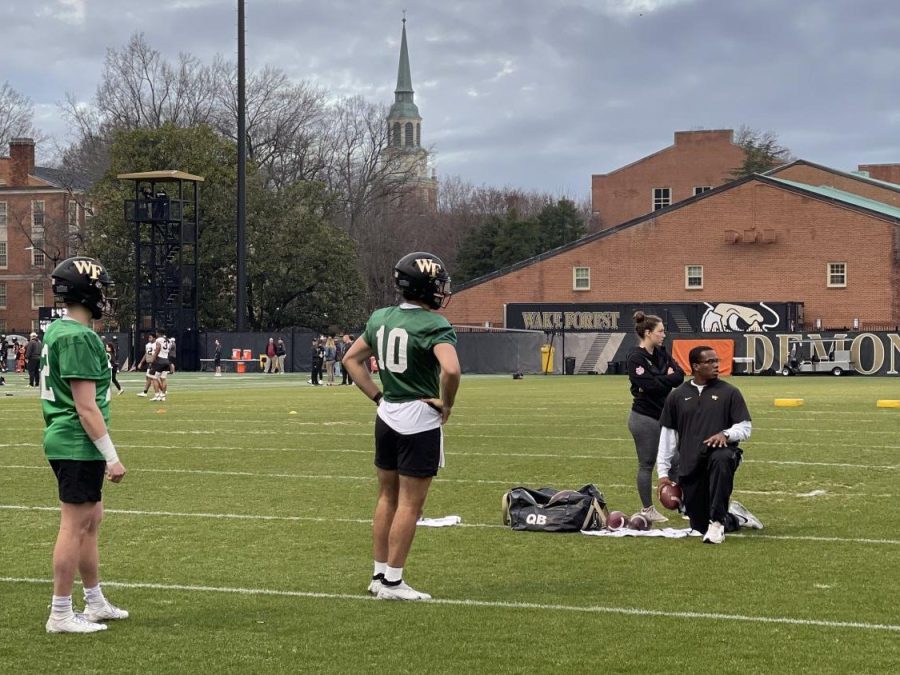
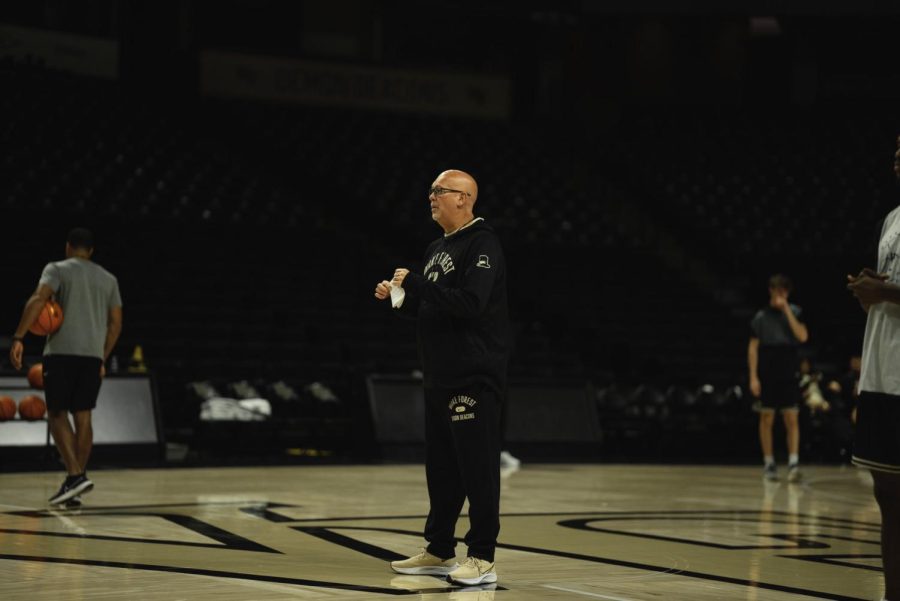
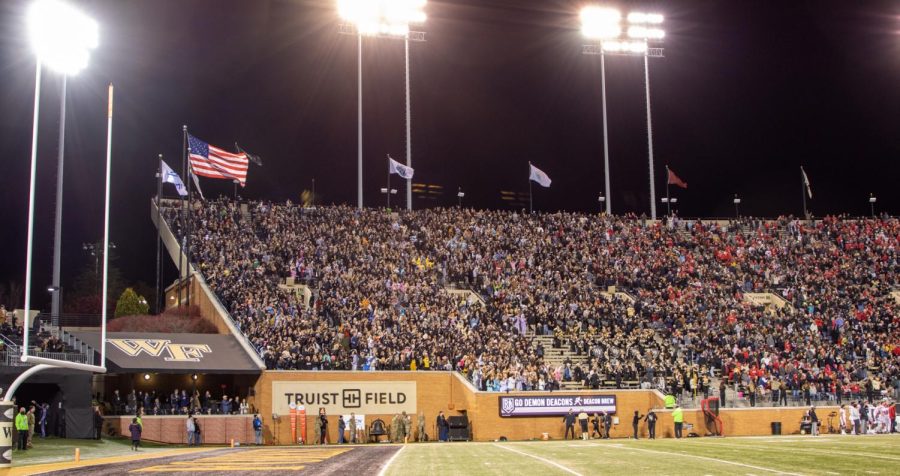
Milt • Apr 9, 2022 at 7:52 am
Beautiful. Well done !